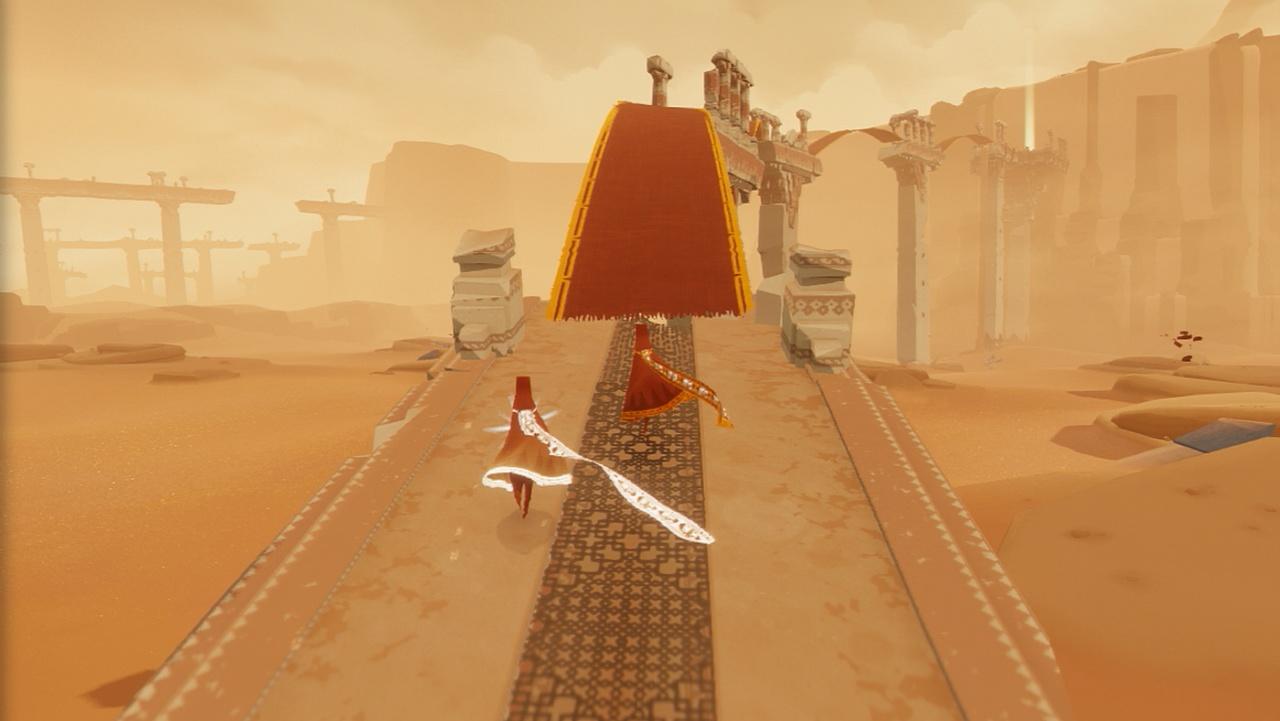Name of Game: Journey
Developer: Thatgamecompany
Platform: PlayStation 3, PlayStation 4, iOS, Windows (what I played on)
Target Audience
Journey is a very interesting game as it tackles themes that are relatable to just about anyone. The narrative and mechanics of the game create a wondrous metaphor for the journey we take through life from birth to death. Given that the mechanics of the game are so simplistic, it doesn’t expect any prior twitch or strategic skill from the player. I believe everyone but children could be included in the target audience as children would likely not understand or appreciate the slow pace or subtle messaging of the game.
Formal Elements and Types of Fun
Journey is a single-player adventure game where you traverse through vast deserts and ruins as a red, robed figure with a scarf. Innately, the player can only walk around and emit a chime sound within a small radius. There are special pieces of fabric scattered throughout the game that, when used with the player’s chime, allow the player to fly into the air for a period of time. The duration of time that a play can propel themselves in the air depends on the length of their scarf. As the player progresses through the game and picks up collectable orbs of light, their scarf gets longer. While the minimalist mechanics of the game don’t offer much fun through challenge, the beautiful soundtrack and landscapes offer a lot of fun via sensation and discovery.
While I said that Journey is a single-player game, that isn’t entirely true. Throughout your game, you can stumble across other players and continue your journey together. Players are only able to communicate through their chimes. When I first encountered another player, I thought they were an NPC, and I was impressed by how they were able to both mimic the pattern of my chime and produce seemingly random patterns. It felt as though I was interacting with a sentient being because I was! I didn’t realize they were a real player until I was near the end of the game. It was certainly a pleasant surprise and added some fun through fellowship.

Narrative
As I was playing Journey, one thing that stood out to me was the way in which the game conveyed narrative. At the start, the player is thrown into an unfamiliar world as an unfamiliar character. There are no voice lines or text to offer guidance. It is entirely up to the player to make sense of what is happening by interacting and moving through the world. I would say that Journey is a great example of an enacted narrative. The story moves the player from one space to the next. In each new space, the player is able to interact with or bear witness to the environment as a means of gaining my insight to the story and their purpose in it. The mechanics synergize with this format of storytelling because by heavily limiting the ways in which the player can interact with the world, it uses the player’s actions (or lack thereof) to convey the powerlessness that people can feel throughout their lives. While I didn’t personally connect with the themes of the game, I found the narrative techniques fresh and enlightening. It is at the core of what makes the game successful.

Moments of Success/Failure:
While Journey’s limited mechanics help in conveying the story of the game, I found them to concurrently be the least enjoyable aspect of the game. I found myself simply holding the forward key for minutes at a time. Sometimes, it almost didn’t feel like I was playing a video game. I understand that perhaps the slow movement forward was meant to parallel the monotony of everyday life, but I question if that is something that needs to be captured in a video game at all. If games are made to be fun, why would they try to capture such a not fun topic in a game? I think adding something as simple as a jump mechanic that the player could use at any time in the game would have added at least a minimal amount of diversity in movement. Moreover, I would have enjoyed it if the default walking speed was a bit faster. The slow movement discouraged me from venturing too far off the path, knowing how long it would take me to get back. I can imagine these all being stylistic choices by the creators; I just personally think they made the gameplay unenjoyable.
Comparison to Other Walking Sims:
I have previously played Firewatch and The Stanley Parable. I find that those games follow more of an embedded narrative style of storytelling. Both have strong narrators that do a lot of the work of bringing the stories to life. Story is treated as a reward for player actions. For example in The Stanley Parable, the player’s actions are rewarded with new voice lines from the comedic narrator. With Firewatch, it feels as though the story could exist in a format other than a videogame; however, it is the visuals of the game and the influence of player choice that allow it to thrive as a videogame. Compared to these two games, I think that Journey does a better job of integrating narrative into its gameplay. Upon completion of Journey, it was clear to me that I couldn’t have gotten the same experience of and perspective on the narrative had it been conveyed through a different medium.



